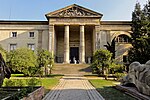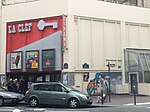National Museum of Natural History, France
1793 establishments in France5th arrondissement of ParisGrands établissementsHerbariaMuseums established in 1793 ... and 3 more
Museums in ParisNational museums of FranceNatural history museums in France

The French National Museum of Natural History, known in French as the Muséum national d'histoire naturelle (abbreviation MNHN), is the national natural history museum of France and a grand établissement of higher education part of Sorbonne Universities. The main museum, with four galleries, is located in Paris, France, within the Jardin des Plantes on the left bank of the River Seine. It was formally founded in 1793 during the French Revolution, but was begun even earlier in 1635 as the royal garden of medicinal plants. The museum now has 14 sites throughout France.
Excerpt from the Wikipedia article National Museum of Natural History, France (License: CC BY-SA 3.0, Authors, Images).National Museum of Natural History, France
Rue Geoffroy Saint-Hilaire, Paris 5th Arrondissement (Paris)
Geographical coordinates (GPS) Address Phone number Website Nearby Places Show on map
Geographical coordinates (GPS)
| Latitude | Longitude |
|---|---|
| N 48.842109 ° | E 2.356286 ° |
Address
Grande Galerie de l'Évolution
Rue Geoffroy Saint-Hilaire
75005 Paris, 5th Arrondissement (Paris)
Ile-de-France, France
Open on Google Maps











